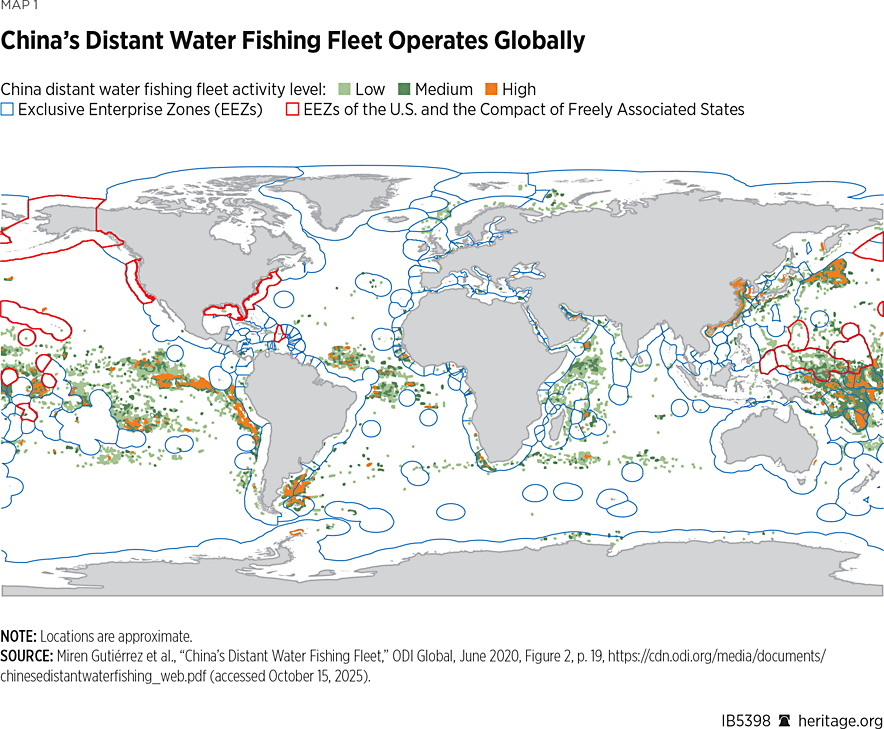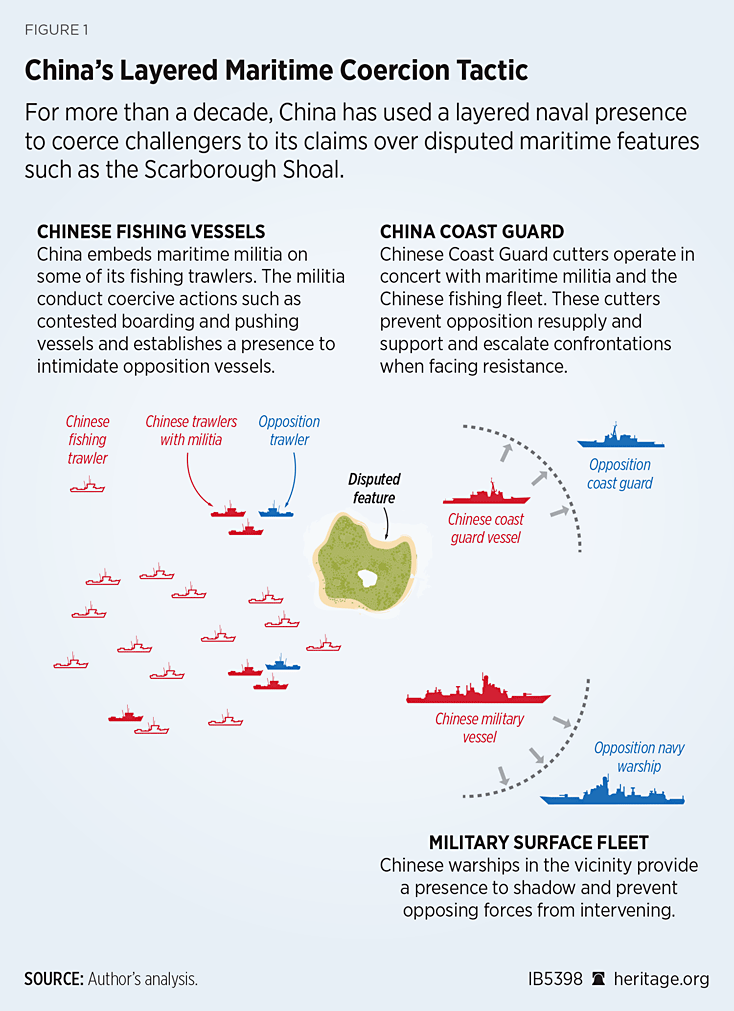The Chinese distant water fishing fleet is comprised of thousands of trawlers working far from Chinese shores, often engaging in illegal fishing from the South Pacific to Western Africa. To smaller nations that are economically and nutritionally dependent on the oceans, this poaching poses an immediate threat, costing them an estimated $50 billion a year.REF
China’s distant water fishing fleet will likely be coming to American waters—if it has not already. To ward off this threat, the United States should better understand and confront the national security threats posed by the Chinese distant water fishing fleet.
China’s Thuggish Behavior at Sea
As fish stocks dwindle near China, distant fish stocks have become ever more lucrative, in recent years driving China’s fleet into distant waters. In the Pacific, vulnerable nations such as Papua New Guinea rely heavily on fishing to provide 44–75 percent of local economies’ income and a diminishing portion of their food.REF These unregulated distant water fishing fleets deplete local fish stocks, depriving island communities of a valuable resource.REF

Seasonal Chinese distant fishing fleets are notorious for poaching in Ecuadorean and Argentine waters at an industrial scale.REF Its large factory ships are equipped with refrigeration and canning machines, functioning as offshore fishery bases. At sea, these vessels often operate beyond coastal states’ awareness and capacity to enforce their authority.REF In the open oceans and occasionally in others’ exclusive economic zones (EEZs), the large number of fishing trawlers—numbering in the hundreds—can be daunting for small coastal states (and even the United States) to regulate.
China’s distant water fishing fleet has been detected using counterfeit tracking and registration data to evade limits on its fishing catches and avoid fees, similar to the illicit Russian oil trade.REF More pressing, however, is that as coastal states attempt to rein in illegal fishing in their EEZs, China could use its paramilitary maritime militia and coast guard to push back.REF This is now playing out over the contested South China Sea Scarborough Shoal and Whitsun Reef.REF For many years Chinese fishing vessels have integrated maritime militia on trawlers operating with the Chinese Coast Guard to intimidate southeast Asian fishermen and maritime enforcement agencies using gray-zone tactics.REF If embedded in more distant fishing operations, the maritime militia could complicate even further the ability of smaller nations to stop poaching in their waters.REF Though not acknowledged—yet—the potential is high for poaching in U.S. waters given the proximity to American EEZs of these large and unregulated Chinese distant water fishing fleets.
The potential for industrial-scale poaching in American waters threatens local livelihoods, but Chinese fishing fleets are doing more than illegal fishing. China is the most active perpetrator of illegal fishing and its potential for crossing over into other illegal activities cannot be discounted, to include in U.S. waters.REF Moreover, researchers at The Heritage Foundation have heard firsthand reports of Chinese fishing fleets smuggling items such as counterfeit cigarettes into Latin America.

The Distant Water Fleet and the Drug Trade
It is likely that China’s distant water fishing fleet—which is already engaging in illegal fishing, trade in counterfeit cigarettes, and human trafficking—will graduate to even more lucrative fentanyl precursor chemicals or cocaine.REF Throughout the world, fishing vessels have engaged in the smuggling of drugs and precursor chemicals, an illicit trade worth about $80 billion a year or 15 percent of the total revenue of drugs worldwide.REF Given that the precursors for producing fentanyl come mainly from China, the participation of these fishing vessels in the drug trade may already be happening.REF
On addressing the narcotics threat, President Donald Trump has been clear: “To every terrorist thug smuggling poisonous drugs into the United States of America, please be warned—we will blow you out of existence,” Trump said while addressing the U.N. on September 23, and that is exactly what he has been doing in Venezuela.REF On October 21, U.S. forces struck a drug boat for the first time in the Eastern Pacific.REF
Illegal Activities in Latin America
China’s contributions to illicit trade has exacerbated drug cartels’ corrosive influence on Latin American governance. The Bang Group, a notorious Chinese criminal gang, has participated in human trafficking, narcotics smuggling, and the counterfeit cigarette trade. The money earned enables the corruption of officials and pliable banks to facilitate money laundering.REF The Bang Group is operating within South America, providing a ready partner for expanded illicit trades buoyed by Chinese distant water fishing fleets. Consider the lucrative trade in counterfeit cigarettes, with Panama and Colombia being major points of entry into the region.REF
The China National Tobacco Corporation is the world’s largest producer and the largest illegal supplier, leveraging easy access through the free trade zone in Colón, Panama, to move illicit cargo into containers for transshipment.REF Should scrutiny grow on these operations, illicit cargo will have to move on less risky routes—potentially involving the distant water fishing fleet.
The cartels and China’s fishing fleet would not be able to turn a profit in their illicit trade without some official support or acquiescence. For its part, the Chinese Communist Party passively benefits from the chaos and erosion of society these narco-terrorist organizations sow in neighboring countries, resulting in more pliable governments and vulnerable political leaders.
The Chinese Communist Party’s support for cartels in Latin America manifests as lax money laundering enforcement and controls on fentanyl precursor chemical shipments. In 2024, the Department of Justice announced that the Sinaloa Cartel was found to be working with underground Chinese banks to launder drug trafficking profits.REF On September 3, 2025, the Justice Department announced that 300,000 kilograms of precursor chemicals from China were interdicted at the Port of Houston. These chemicals were destined for a Sinaloa Cartel lab in Mexico.REF
Moreover, Venezuela under President Nicolas Maduro has become a “narco state” where China has been significantly increasing ties since 2000. China’s investment in Venezuelan oil was initially meant to wean Venezuela’s petroleum industry away from its long-standing customer in the United States. Despite the surge in Venezuelan trade with China, since 2016 Venezuela has seen a 60 percent reduction in crude oil production, leading the Maduro regime to turn to other sources of income,REF such as illicitly mined gold and drug trafficking, which have implicated numerous Maduro regime members.REF
Unsurprisingly, Venezuela joined China’s Belt and Road Initiative in 2018, and in exchange for oil in 2019, Venezuela received Chinese weapons for its navy.REF
Areas of Cooperation
The United States has limited maritime policing forces, so to effectively combat illegal fishing and drug trafficking at sea, information sharing among nations across the Pacific and Latin America is critical, and regional information fusion centers should play a part.
A Pacific information fusion center would bring together intelligence specialists, maritime enforcement agencies, and even local fishermen to report illicit activities.REF Malaysia’s chief of navy championed similar approaches with the release of the K3M application, enabling fishermen to report illegal activity with location data to maritime information centers by cell phone.REF Such real-time collection of information can facilitate real-time responses.
Shiprider programs have also been used effectively, notably in the central and south Pacific. These patrols involve a participating nation sending a maritime enforcement official to a U.S. warship or cutter to execute enforcement measures from the U.S. vessel in the partner nation’s EEZ. More of these agreements are needed.REF Frameworks for such agreements, such as the Niue Treaty and Subsidiary Agreement, allow member nations to patrol other member nations’ EEZs and prosecute violators.REF Moreover, during the COVID pandemic, some shiprider partner island nations deputized via FaceTime shiprider partner nations to enforce maritime rights in their waters. This deputization should be used more often given the limited number of island officials and limited platforms for conducting enforcement operations.
One area of concern is the Gulf of America, where 511 vessels were suspected in 2023–2024 of illegal fishing, of which the U.S. Coast Guard could interdict only 114.REF “While more than 75 percent of the Coast Guard’s interdictions in 2023 were cued by intelligence, the unexpected unavailability of the Coast Guard’s aging major cutters and other assets used to detect all the cued drug events limited our ability to interdict more smuggling operations,” said Rear Admiral Jo-Ann F. Burdian during a House Committee meeting in 2023.REF Although Congress allocated $687 million to combat illegal fishing, fewer operations were conducted, with an average of $5.9 million spent on each encounter.REF To increase maritime domain awareness across and interdictions of poaching within American EEZs, the U.S. Coast Guard will need more cutters and aircraft.
Finally, unmanned vessels are also instrumental in surveying large areas of water.REF Not only would this provide intelligence, but it would help smaller nations in the Indo-Pacific respond to violations of their territory.
Recommendations
- Assess and protect America’s fish stock. The National Oceanic and Atmospheric Administration and the U.S. Coast Guard should assess the value and locations of U.S. fish stocks, including pelagic fish transit routes, to inform areas for maritime patrols. A 2016 study estimated that “U.S. fishermen could be losing $1 billion in revenue” each year due to illegal fishing.REF The effects of illegal fishing on U.S. fishermen are significant, and better monitoring of key areas would help lessen this threat.
- Study where and how the Chinese distant water fishing fleet operates. The CIA, FBI, Coast Guard, and Navy should form a task force to assess and report on the potential and current activity of illicit trade by the Chinese distant water fishing fleet. This would include U.S. waters and territory in addition to international waters of vital importance such as drug trafficking routes. A likely organization to base this task force and mission would be the Joint Interagency Task Force—West, which is based in Hawaii and responsible for coordinating such activities.
- Increase congressional oversight. Congress should conduct a hearing and form an oversight committee to investigate illicit Chinese maritime activities within the EEZs of the United States and other friends and allies.
- Prioritize maritime enforcement in American EEZs. The U.S. Coast Guard should be resourced appropriately and directed to prioritize maritime enforcement in all of America’s EEZs. This will require an expansion of the Coast Guard cutter fleet and associated shoreside installation to sustain needed patrols in distant waters, such as those around American Samoa. A revised force design plan—Program of Record—U.S. Coast Guard is needed to be made public that details the forces needed to patrol America’s waters.
Conclusion
China will not act against its criminal Triads or immoral chemical manufacturers of fentanyl precursor chemicals, because it has nothing to lose by allowing them to continue operating. Yet China’s distant waters fishing fleets stand to complicate U.S. interdiction and degradation of Latin American narco cartels.
Soon the United States will have to act forcefully against the cartels’ smuggling operations in the Pacific, where the Chinese presence is already significant. Enhanced maritime domain awareness—enabled with regional fusion centers and bilateral enforcement agreements—is urgently needed. It would be the first step in deterring China’s Triads and its surrogates from expanding their illicit activities.
Carol Thomason is a member of the Young Leaders Program at The Heritage Foundation. Brent Sadler is a Senior Research Fellow for Naval Warfare and Advanced Technology in the Douglas and Sarah Allison Center for National Security at The Heritage Foundation.



